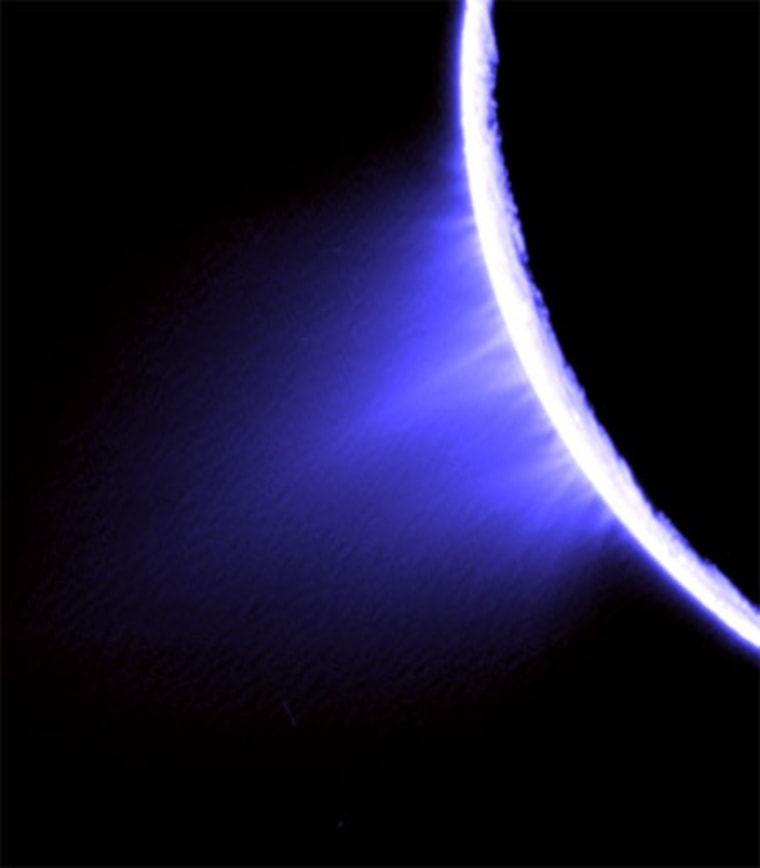The recent discovery of plumes containing water vapor erupting from the south pole of the frigid Saturnian moon Enceladus set off a firestorm of debate.
Many scientists thought the geysers of gaseous water must boil out of liquid water stored under the moon's surface, which would make Enceladus a promising candidate for life.
But a new study challenges that conclusion, arguing that the plumes could just as easily come from ice through the process of sublimation — the direct leap from the solid to gaseous state.
This conclusion may dampen Enceladus' astrobiology hopes, though it does not exclude the possibility of liquid water, and thus life, on the moon.
Cold Faithful
Enceladus' geysers were first spotted in 2005 by NASA's Cassini spacecraft, which was launched in 1997 on a mission to orbit Saturn. Shortly after the discovery, a research group led by Carolyn Porco, head of Cassini's imaging science team, calculated the ratio of water ice to vapor in the plumes. Cassini wasn't able to directly measure the masses of ice and vapor in the plumes, but the researchers estimated the mass of ice from the observed brightness of the plumes (because ice reflects light, so the more ice, the brighter the plumes). They deduced the mass of water vapor from a measurement of the molecular signature of vapor in the wavelengths of light Cassini observed from the plumes.
The scientists found that there were almost equal amounts of ice and water vapor. If this is the case, the researchers argued, the plumes cannot result from the sublimation of ice. The ice crystals are believed to be re-condensed from the vapor, rather than directly ejected from the surface or subsurface of the moon. A lot of vapor is needed to produce that 50/50 ice and vapor ratio, but the laws of thermodynamics prevent that much vapor from being produced solely by sublimation. Therefore, some of the vapor must be produced by evaporation rather than sublimation. This means a vast reserve of liquid water must exist on Enceladus, perhaps as shallow as 23 feet (7 m) under the surface. Under this theory, the researchers dubbed Enceladus' plumes "Cold Faithful" after the Old Faithful geyser in Yellowstone National Park. Their paper was published in 2006 in the journal Science.
Slideshow 12 photos
Month in Space: January 2014
But a new study led by Susan Kieffer of the University of Illinois at Urbana-Champaign challenges that work. She and her colleagues recalculated the ice-to-vapor ratio and produced vastly different results. Under their calculations, vapor is much more abundant than ice, with their final ratio less than 2:10, compared to the previous team's estimate of 1:1.
"We simply redid the calculations described in the [previous] paper and found that we could not reproduce the results quoted for either the abundance of vapor or the abundance of ice," Kieffer said. "Our conclusion was that sublimation should not have been excluded from consideration as a process that could produce the measured quantities, and thus should be considered as thoroughly as the liquid water hypothesis. Unfortunately, it has not been."
Kieffer and team published their findings in the May 2009 issue of the journal Icarus.
Conflicting interpretations
The two contradicting conclusions paint a vastly different picture of Enceladus. Under the first, the moon has an icy veneer that masks a dynamic region of flowing water under the surface that could possibly host life. But another interpretation sees Enceladus as a frigid world, solid with ice and rock all the way through.
"Water is certainly present in Enceladus, at least as solid and vapor, but the presence of vapor does not necessarily imply that liquid water is present," Kieffer wrote with Brucke Jakosky, a scientist at the University of Colorado in Boulder, in an essay in the June 13, 2008 issue of Science. "A definitive answer about the potential for life may have to await a follow-on spacecraft mission that can make specific high-resolution observations that could distinguish between the competing models."
The authors of the original paper, with the more hopeful outlook on the possibility of liquid water on the moon, agree that more work is needed to solve the conundrum and understand the conflicting estimates of the plumes' ice-to-vapor ratio.
"Serious analysis of the Enceladus plume images are only just beginning on the imaging team, and the jury is still very much out on this subject," Porco said in response to the new paper.
Andrew Ingersoll, a planetary scientist at Caltech, was involved with the original Porco et al. estimate, but said he doesn't believe that either ratio is truly accurate.
"Right now, I am not convinced by anyone's estimates of the ice/vapor ratio," he said. Ingersoll is currently working on a new, revised estimate.
Cassini is also scheduled to make future flybys of the moon, which could help refine the estimates.
"There are a number of reasons that the ice/vapor ratio cannot be used to prove or disprove either model," Kieffer said. "Nevertheless, it was the ice/vapor ratio from the original paper that gave the liquid water hypothesis its momentum. The point of our Icarus paper is that this value was miscalculated, that two competing hypotheses should have been set in motion, and both should still be considered by the scientific community."
The intriguing possibilities and conflicting interpretations of Enceladus are reasons why many scientists are pushing for a dedicated spacecraft mission to the moon. Though no official plans exist, a number of proposals are currently being considered for future NASA and ESA (European Space Agency) missions.

